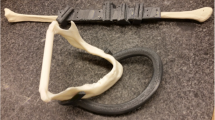Abstract
Introduction
As computer simulation for rhinoplasty continues to rise, the technology’s utility extends beyond increasing patient conversion. Virtual simulation of the surgical result can assist with surgical planning and intraoperative decision-making. 3D printed anatomic models or surgical guides based on 3D images may help align surgeons with their original surgical plan. This study aims to evaluate the utility of 3D printed surgical guides as an intraoperative tool to help establish dorsal height and tip position.
Methods
Patients undergoing rhinoplasty had preoperative virtual 3D surgical simulations performed. Simulations were used to create a 3D printed nasal kits containing ceramic models of the preoperative nose and simulated nose, sagittal contour guide, and customized postoperative nasal splint. Nasal guides were sterilized for continual intraoperative assessment of profile contour (i.e., dorsal height and tip position). Postoperative 3D images (1–3 months post-op) were then compared to preoperative simulations. The difference between z coordinates and y coordinates determined the difference in projection and rotation, respectively.
Results
Fifteen patients met inclusion criteria for this study. With the use of 3D printed surgical guides, the final tip position was on average of 0.8±0.7mm from simulated projection and 0.3±0.2mm from simulated rotation. Similarly, projection for the cartilaginous and bony dorsum was within 1.0±0.8 and 0.8±0.7mm of the simulation, respectively.
Conclusion
Virtual simulation is useful in defining aesthetic goals preoperatively, but the potential clinical value extends beyond this. 3D printed rhinoplasty guides extend the simulation’s utility to decision-making intraoperatively. This technology offers a novel medium for anatomic reference, which may improve adherence to desired aesthetic goals.
Level of Evidence V
This journal requires that authors assign a level of evidence to each article. For a full description of these Evidence-Based Medicine Ratings, please refer to Table of Contents or online Instructions to Authors www.springer.com/00266.




Similar content being viewed by others
References
Pfaff MJ, Steinbacher DM (2016) Plastic surgery applications using three-dimensional planning and computer-assisted design and manufacturing. Plastic Reconstruct Surg J Am Soc Plastic Surg. 137(3):603e–616e
Weissler JM, Stern CS, Schreiber JE, Amirlak B, Tepper OM (2017) The evolution of photography and three-dimensional imaging in plastic surgery. Plastic Reconstruct Surge J Am Soc Plastic Surg 139(3):761–769
Guyuron B, Precision rhinoplasty, (1988) Part II: Prediction. Plastic and reconstructive surgery: J Am Soc Plastic Surg 81(4):500–505
Sharp HR, Tingay RS, Coman S, Mills V, Roberts DN (2002) Computer imaging and patient satisfaction in rhinoplasty surgery. J Laryngol Otol 116(12):1009–1013
GökçeKütük S, Arıkan OK (2019) Evaluation of the effects of open and closed rhinoplasty on the psychosocial stress level and quality of life of rhinoplasty patients. J Plast, Reconstruct Aesthet Surg. 72(8):1347–1354
Mehta U, Mazhar K, Frankel AS (2010) Accuracy of preoperative computer imaging in rhinoplasty. Arch Facial Plastic Surg 12(6):394–398
Adelson RT, DeFatta RJ, Bassischis BA (2008) Objective assessment of the accuracy of computer-simulated imaging in rhinoplasty. Am J Otolaryngol 29(3):151–155
Choi JW, Kim MJ, Kang MK et al (2020) Clinical application of a patient-specific, three-dimensional printing guide based on computer simulation for rhinoplasty. Plastic and reconstruct surg J Am Soc Plast Surg 145(2):365–374
Tepper OM, Sorice S, Hershman GN, Saadeh P, Levine JP, Hirsch D (2011) Use of virtual 3-dimensional surgery in post-traumatic craniomaxillofacial reconstruction. J Oral Maxillofacial surg. 69(3):733–741
Zamborsky R, Kilian M, Jacko P, Bernadic M, Hudak R (2019) Perspectives of 3D printing technology in orthopaedic surgery. Bratislavské lékarské listy 120(7):498–504
Suszynski TM, Serra JM, Weissler JM, Amirlak B (2018) Three-dimensional printing in rhinoplasty. Plast Reconst Surg: J Am Soc Plast Surg 141(6):1383–1385
Yen C-I, Zelken JA, Chang C-S et al (2019) Computer-aided design and three-dimensional printing improves symmetry in heminasal reconstruction outcomes. J Plast Reconstr Aesthet Surg 72(7):1198–1206. https://doi.org/10.1016/j.bjps.2019.03.012
Sultan B, Byrne PJ (2011) Custom-made, 3D, intraoperative surgical guides for nasal reconstruction. Facial plast surg clinics North Am 19(4):647–653
Pavri S, Zhu VZ, Steinbacher DM (2016) Postoperative edema resolution following rhinoplasty: a three-dimensional morphometric assessment. Plastic Reconst Surg J Am Soc Plastic Surg 138(6):973e–979e
Author information
Authors and Affiliations
Corresponding author
Ethics declarations
Conflict of interest
Oren Tepper is a shareholder of MirrorMe3D.
Ethical Approval
All procedures performed in studies involving human participants were in accordance with the ethical standards of the institutional and/or national research committee and with the 1964 Helsinki declaration and its later amendments or comparable ethical standards.
Informed Consent
For this type of study, formal consent is not required.
Additional information
Publisher's Note
Springer Nature remains neutral with regard to jurisdictional claims in published maps and institutional affiliations.
Rights and permissions
About this article
Cite this article
Gordon, A.R., Schreiber, J.E., Patel, A. et al. 3D Printed Surgical Guides Applied in Rhinoplasty to Help Obtain Ideal Nasal Profile. Aesth Plast Surg 45, 2852–2859 (2021). https://doi.org/10.1007/s00266-021-02350-z
Received:
Accepted:
Published:
Issue Date:
DOI: https://doi.org/10.1007/s00266-021-02350-z




